University Investment Management Report: Active and Passive Strategies
VerifiedAdded on 2020/05/16
|13
|2662
|70
Report
AI Summary
This report provides a comprehensive analysis of active and passive investment portfolio strategies. It begins by explaining the strategies employed in an active portfolio, including market timing and value screening, and their basis in financial theory. The report then critically evaluates and compares the returns of both active and passive portfolios over a seven-year period, highlighting the impact of different investment approaches and the role of portfolio weights. The analysis delves into the performance of various stocks within the active portfolio, including SRI and non-SRI stocks, and discusses the implications of these results in relation to empirical research and financial theories such as the efficient market hypothesis. The findings underscore the importance of risk management and the selection of appropriate investment strategies to optimize portfolio performance. The passive portfolio underperformed, with the active portfolio also incurring losses, pointing to the need for a refined approach.

Running head: INVESTMENT MANAGEMENT
Investment Management
Name of the Student:
Name of the University:
Authors Note:
Investment Management
Name of the Student:
Name of the University:
Authors Note:
Paraphrase This Document
Need a fresh take? Get an instant paraphrase of this document with our AI Paraphraser
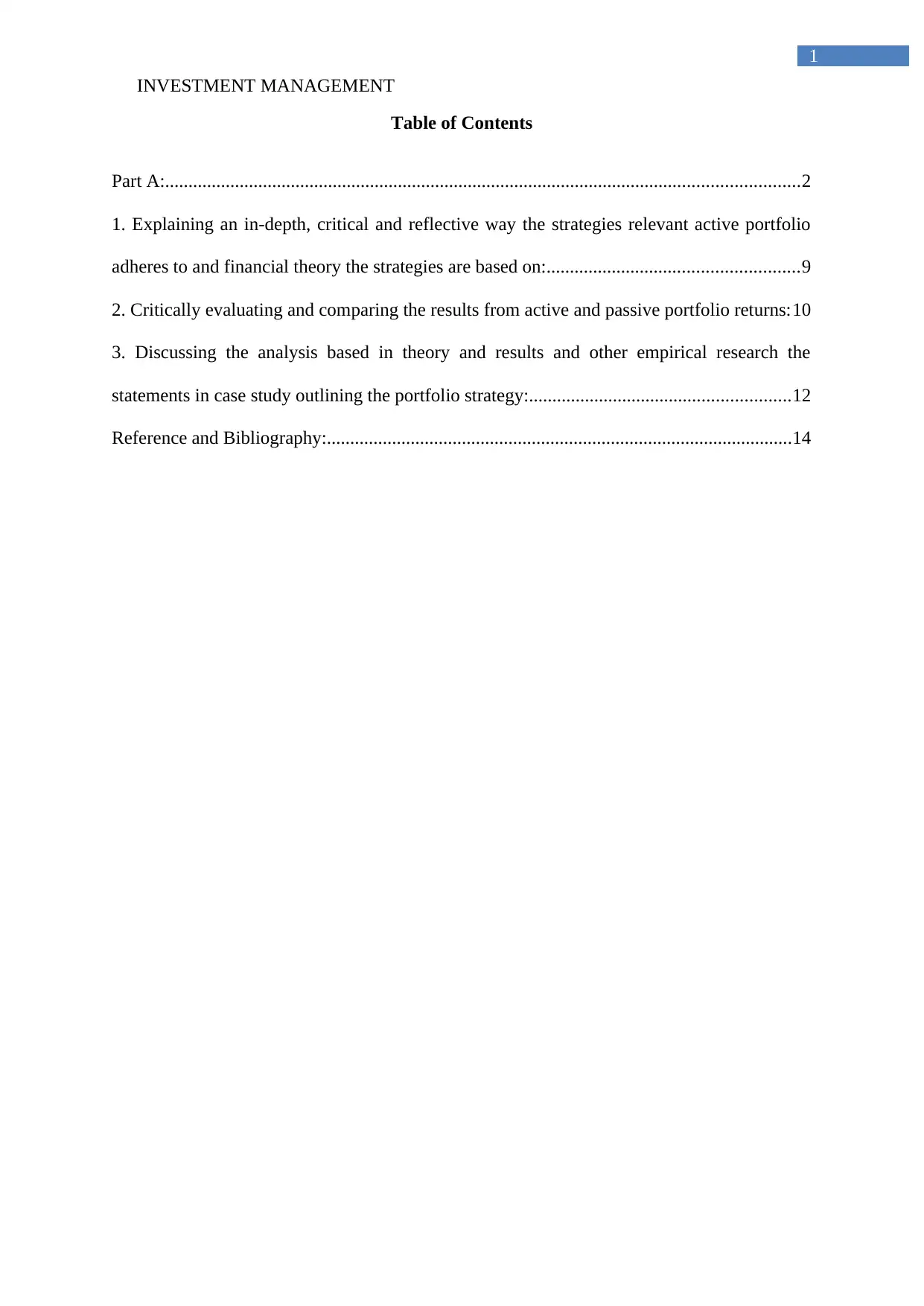
INVESTMENT MANAGEMENT
1
Table of Contents
Part A:........................................................................................................................................2
1. Explaining an in-depth, critical and reflective way the strategies relevant active portfolio
adheres to and financial theory the strategies are based on:......................................................9
2. Critically evaluating and comparing the results from active and passive portfolio returns:10
3. Discussing the analysis based in theory and results and other empirical research the
statements in case study outlining the portfolio strategy:........................................................12
Reference and Bibliography:....................................................................................................14
1
Table of Contents
Part A:........................................................................................................................................2
1. Explaining an in-depth, critical and reflective way the strategies relevant active portfolio
adheres to and financial theory the strategies are based on:......................................................9
2. Critically evaluating and comparing the results from active and passive portfolio returns:10
3. Discussing the analysis based in theory and results and other empirical research the
statements in case study outlining the portfolio strategy:........................................................12
Reference and Bibliography:....................................................................................................14
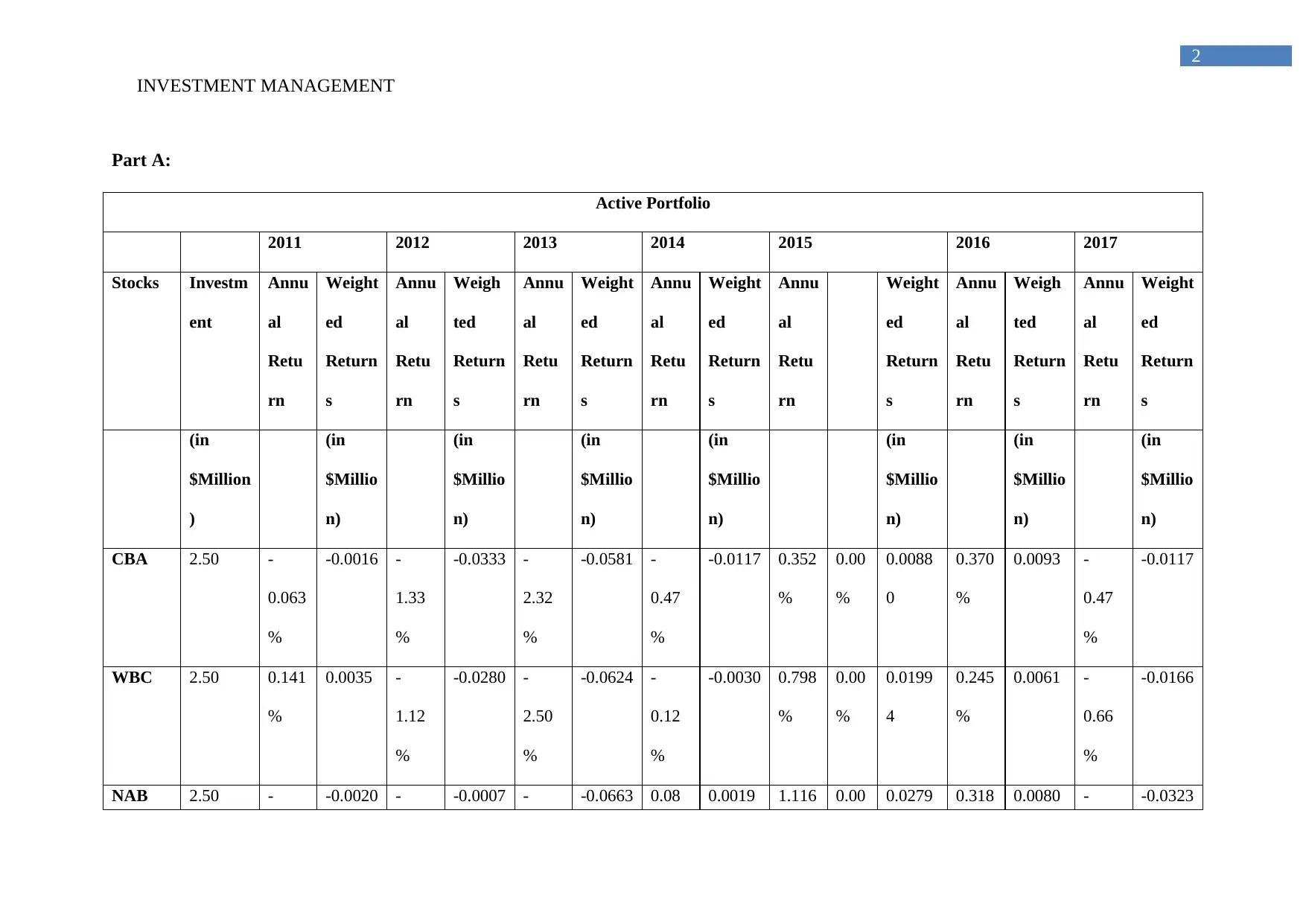
INVESTMENT MANAGEMENT
2
Part A:
Active Portfolio
2011 2012 2013 2014 2015 2016 2017
Stocks Investm
ent
Annu
al
Retu
rn
Weight
ed
Return
s
Annu
al
Retu
rn
Weigh
ted
Return
s
Annu
al
Retu
rn
Weight
ed
Return
s
Annu
al
Retu
rn
Weight
ed
Return
s
Annu
al
Retu
rn
Weight
ed
Return
s
Annu
al
Retu
rn
Weigh
ted
Return
s
Annu
al
Retu
rn
Weight
ed
Return
s
(in
$Million
)
(in
$Millio
n)
(in
$Millio
n)
(in
$Millio
n)
(in
$Millio
n)
(in
$Millio
n)
(in
$Millio
n)
(in
$Millio
n)
CBA 2.50 -
0.063
%
-0.0016 -
1.33
%
-0.0333 -
2.32
%
-0.0581 -
0.47
%
-0.0117 0.352
%
0.00
%
0.0088
0
0.370
%
0.0093 -
0.47
%
-0.0117
WBC 2.50 0.141
%
0.0035 -
1.12
%
-0.0280 -
2.50
%
-0.0624 -
0.12
%
-0.0030 0.798
%
0.00
%
0.0199
4
0.245
%
0.0061 -
0.66
%
-0.0166
NAB 2.50 - -0.0020 - -0.0007 - -0.0663 0.08 0.0019 1.116 0.00 0.0279 0.318 0.0080 - -0.0323
2
Part A:
Active Portfolio
2011 2012 2013 2014 2015 2016 2017
Stocks Investm
ent
Annu
al
Retu
rn
Weight
ed
Return
s
Annu
al
Retu
rn
Weigh
ted
Return
s
Annu
al
Retu
rn
Weight
ed
Return
s
Annu
al
Retu
rn
Weight
ed
Return
s
Annu
al
Retu
rn
Weight
ed
Return
s
Annu
al
Retu
rn
Weigh
ted
Return
s
Annu
al
Retu
rn
Weight
ed
Return
s
(in
$Million
)
(in
$Millio
n)
(in
$Millio
n)
(in
$Millio
n)
(in
$Millio
n)
(in
$Millio
n)
(in
$Millio
n)
(in
$Millio
n)
CBA 2.50 -
0.063
%
-0.0016 -
1.33
%
-0.0333 -
2.32
%
-0.0581 -
0.47
%
-0.0117 0.352
%
0.00
%
0.0088
0
0.370
%
0.0093 -
0.47
%
-0.0117
WBC 2.50 0.141
%
0.0035 -
1.12
%
-0.0280 -
2.50
%
-0.0624 -
0.12
%
-0.0030 0.798
%
0.00
%
0.0199
4
0.245
%
0.0061 -
0.66
%
-0.0166
NAB 2.50 - -0.0020 - -0.0007 - -0.0663 0.08 0.0019 1.116 0.00 0.0279 0.318 0.0080 - -0.0323
⊘ This is a preview!⊘
Do you want full access?
Subscribe today to unlock all pages.

Trusted by 1+ million students worldwide
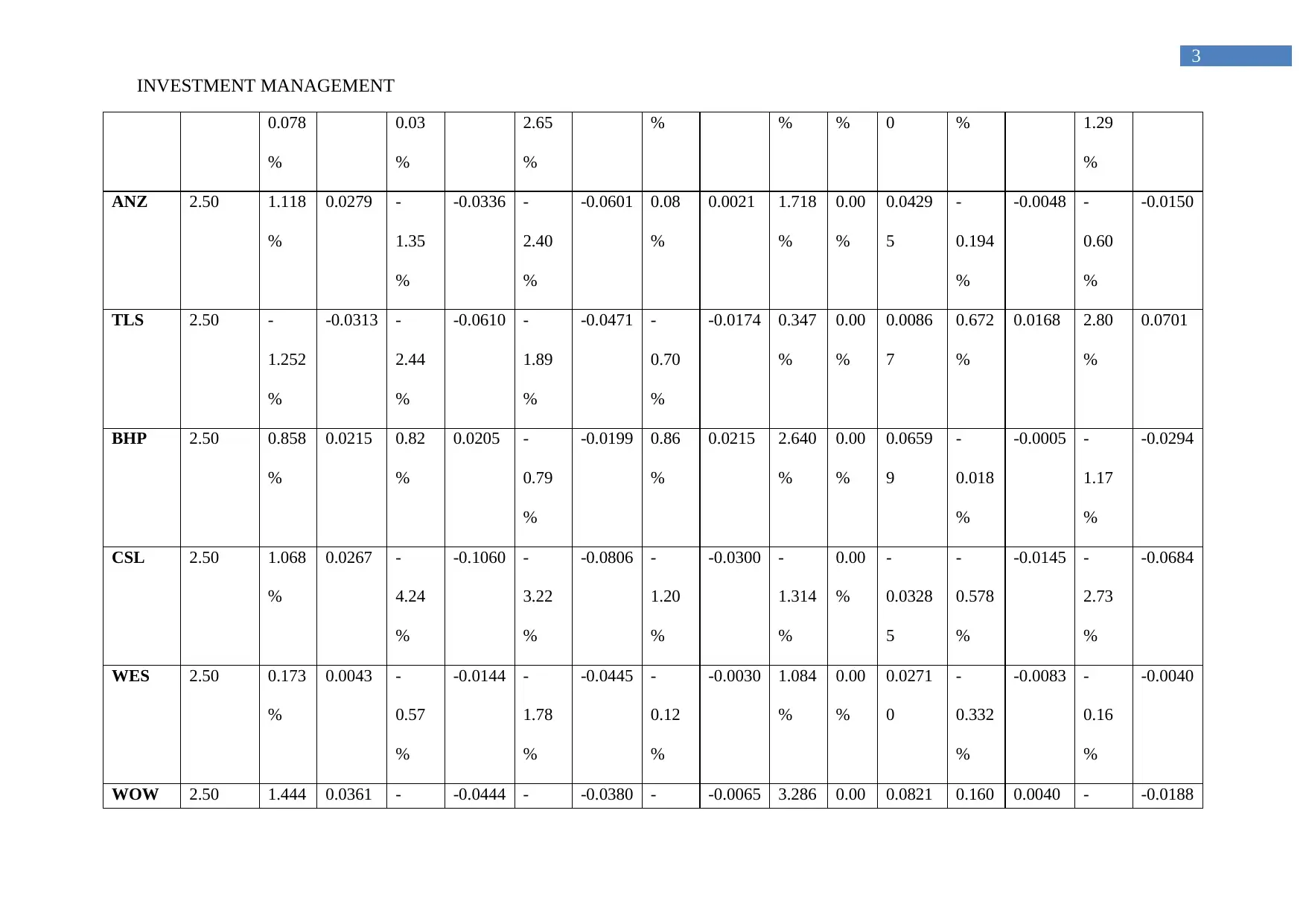
INVESTMENT MANAGEMENT
3
0.078
%
0.03
%
2.65
%
% % % 0 % 1.29
%
ANZ 2.50 1.118
%
0.0279 -
1.35
%
-0.0336 -
2.40
%
-0.0601 0.08
%
0.0021 1.718
%
0.00
%
0.0429
5
-
0.194
%
-0.0048 -
0.60
%
-0.0150
TLS 2.50 -
1.252
%
-0.0313 -
2.44
%
-0.0610 -
1.89
%
-0.0471 -
0.70
%
-0.0174 0.347
%
0.00
%
0.0086
7
0.672
%
0.0168 2.80
%
0.0701
BHP 2.50 0.858
%
0.0215 0.82
%
0.0205 -
0.79
%
-0.0199 0.86
%
0.0215 2.640
%
0.00
%
0.0659
9
-
0.018
%
-0.0005 -
1.17
%
-0.0294
CSL 2.50 1.068
%
0.0267 -
4.24
%
-0.1060 -
3.22
%
-0.0806 -
1.20
%
-0.0300 -
1.314
%
0.00
%
-
0.0328
5
-
0.578
%
-0.0145 -
2.73
%
-0.0684
WES 2.50 0.173
%
0.0043 -
0.57
%
-0.0144 -
1.78
%
-0.0445 -
0.12
%
-0.0030 1.084
%
0.00
%
0.0271
0
-
0.332
%
-0.0083 -
0.16
%
-0.0040
WOW 2.50 1.444 0.0361 - -0.0444 - -0.0380 - -0.0065 3.286 0.00 0.0821 0.160 0.0040 - -0.0188
3
0.078
%
0.03
%
2.65
%
% % % 0 % 1.29
%
ANZ 2.50 1.118
%
0.0279 -
1.35
%
-0.0336 -
2.40
%
-0.0601 0.08
%
0.0021 1.718
%
0.00
%
0.0429
5
-
0.194
%
-0.0048 -
0.60
%
-0.0150
TLS 2.50 -
1.252
%
-0.0313 -
2.44
%
-0.0610 -
1.89
%
-0.0471 -
0.70
%
-0.0174 0.347
%
0.00
%
0.0086
7
0.672
%
0.0168 2.80
%
0.0701
BHP 2.50 0.858
%
0.0215 0.82
%
0.0205 -
0.79
%
-0.0199 0.86
%
0.0215 2.640
%
0.00
%
0.0659
9
-
0.018
%
-0.0005 -
1.17
%
-0.0294
CSL 2.50 1.068
%
0.0267 -
4.24
%
-0.1060 -
3.22
%
-0.0806 -
1.20
%
-0.0300 -
1.314
%
0.00
%
-
0.0328
5
-
0.578
%
-0.0145 -
2.73
%
-0.0684
WES 2.50 0.173
%
0.0043 -
0.57
%
-0.0144 -
1.78
%
-0.0445 -
0.12
%
-0.0030 1.084
%
0.00
%
0.0271
0
-
0.332
%
-0.0083 -
0.16
%
-0.0040
WOW 2.50 1.444 0.0361 - -0.0444 - -0.0380 - -0.0065 3.286 0.00 0.0821 0.160 0.0040 - -0.0188
Paraphrase This Document
Need a fresh take? Get an instant paraphrase of this document with our AI Paraphraser
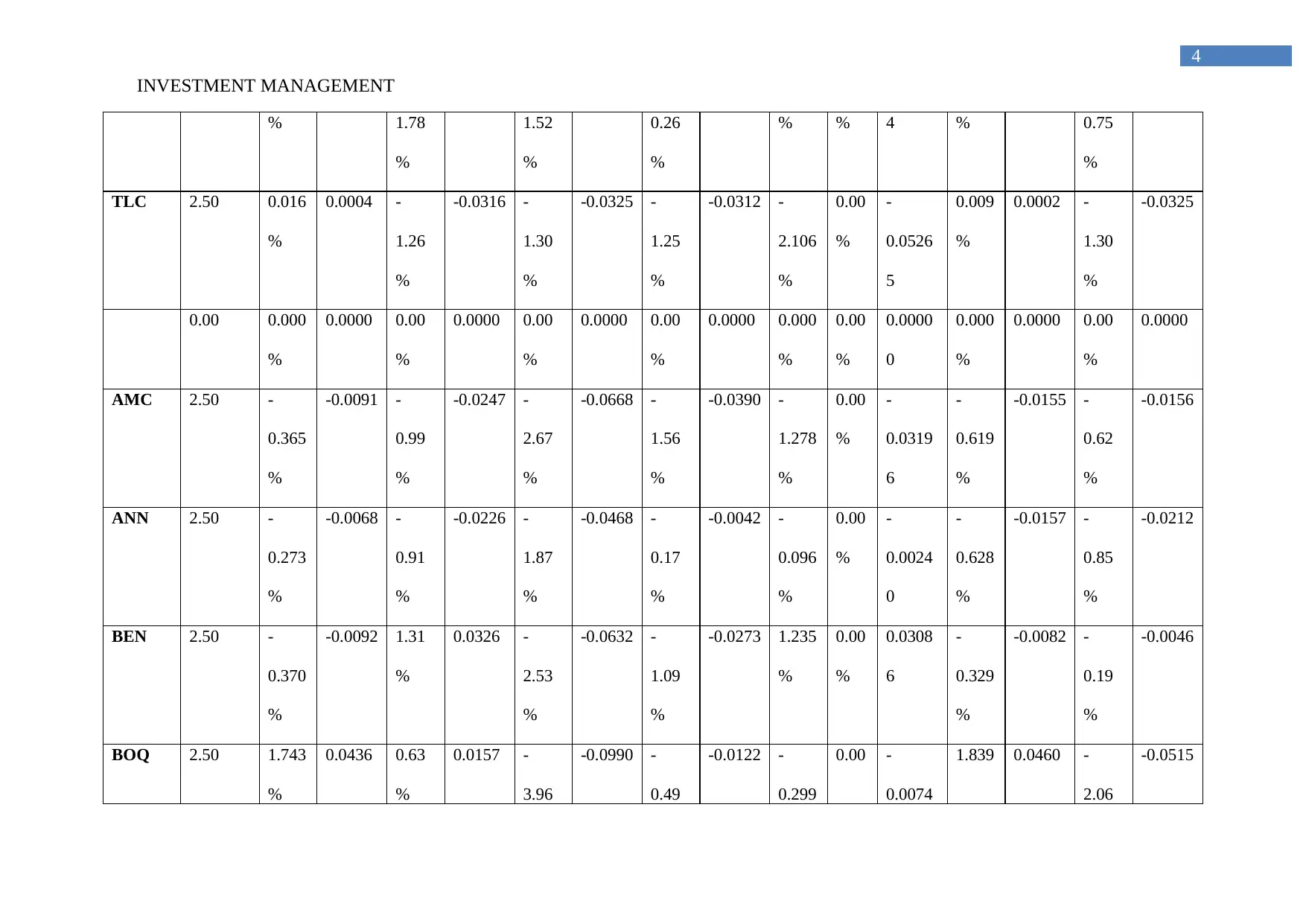
INVESTMENT MANAGEMENT
4
% 1.78
%
1.52
%
0.26
%
% % 4 % 0.75
%
TLC 2.50 0.016
%
0.0004 -
1.26
%
-0.0316 -
1.30
%
-0.0325 -
1.25
%
-0.0312 -
2.106
%
0.00
%
-
0.0526
5
0.009
%
0.0002 -
1.30
%
-0.0325
0.00 0.000
%
0.0000 0.00
%
0.0000 0.00
%
0.0000 0.00
%
0.0000 0.000
%
0.00
%
0.0000
0
0.000
%
0.0000 0.00
%
0.0000
AMC 2.50 -
0.365
%
-0.0091 -
0.99
%
-0.0247 -
2.67
%
-0.0668 -
1.56
%
-0.0390 -
1.278
%
0.00
%
-
0.0319
6
-
0.619
%
-0.0155 -
0.62
%
-0.0156
ANN 2.50 -
0.273
%
-0.0068 -
0.91
%
-0.0226 -
1.87
%
-0.0468 -
0.17
%
-0.0042 -
0.096
%
0.00
%
-
0.0024
0
-
0.628
%
-0.0157 -
0.85
%
-0.0212
BEN 2.50 -
0.370
%
-0.0092 1.31
%
0.0326 -
2.53
%
-0.0632 -
1.09
%
-0.0273 1.235
%
0.00
%
0.0308
6
-
0.329
%
-0.0082 -
0.19
%
-0.0046
BOQ 2.50 1.743
%
0.0436 0.63
%
0.0157 -
3.96
-0.0990 -
0.49
-0.0122 -
0.299
0.00 -
0.0074
1.839 0.0460 -
2.06
-0.0515
4
% 1.78
%
1.52
%
0.26
%
% % 4 % 0.75
%
TLC 2.50 0.016
%
0.0004 -
1.26
%
-0.0316 -
1.30
%
-0.0325 -
1.25
%
-0.0312 -
2.106
%
0.00
%
-
0.0526
5
0.009
%
0.0002 -
1.30
%
-0.0325
0.00 0.000
%
0.0000 0.00
%
0.0000 0.00
%
0.0000 0.00
%
0.0000 0.000
%
0.00
%
0.0000
0
0.000
%
0.0000 0.00
%
0.0000
AMC 2.50 -
0.365
%
-0.0091 -
0.99
%
-0.0247 -
2.67
%
-0.0668 -
1.56
%
-0.0390 -
1.278
%
0.00
%
-
0.0319
6
-
0.619
%
-0.0155 -
0.62
%
-0.0156
ANN 2.50 -
0.273
%
-0.0068 -
0.91
%
-0.0226 -
1.87
%
-0.0468 -
0.17
%
-0.0042 -
0.096
%
0.00
%
-
0.0024
0
-
0.628
%
-0.0157 -
0.85
%
-0.0212
BEN 2.50 -
0.370
%
-0.0092 1.31
%
0.0326 -
2.53
%
-0.0632 -
1.09
%
-0.0273 1.235
%
0.00
%
0.0308
6
-
0.329
%
-0.0082 -
0.19
%
-0.0046
BOQ 2.50 1.743
%
0.0436 0.63
%
0.0157 -
3.96
-0.0990 -
0.49
-0.0122 -
0.299
0.00 -
0.0074
1.839 0.0460 -
2.06
-0.0515

INVESTMENT MANAGEMENT
5
% % % % 8 % %
CIM 2.50 4.053
%
0.1013 1.64
%
0.0411 0.00
%
-0.0001 -
1.71
%
-0.0428 -
1.960
%
0.00
%
-
0.0490
0
-
0.546
%
-0.0136 -
4.18
%
-0.1044
FLT 2.50 1.143
%
0.0286 -
2.46
%
-0.0614 -
5.73
%
-0.1432 1.77
%
0.0441 0.826
%
0.00
%
0.0206
4
0.943
%
0.0236 -
2.73
%
-0.0683
MFG 2.50 -
0.797
%
-0.0199 -
8.60
%
-0.2151 -
9.27
%
-0.2316 -
1.56
%
-0.0391 -
4.406
%
0.00
%
-
0.1101
4
0.471
%
0.0118 -
1.10
%
-0.0274
MQG 2.50 3.067
%
0.0767 -
2.08
%
-0.0521 -
3.98
%
-0.0995 -
1.68
%
-0.0419 -
2.850
%
0.00
%
-
0.0712
5
0.593
%
0.0148 -
1.76
%
-0.0439
PPT 2.50 4.153
%
0.1038 -
1.73
%
-0.0432 -
4.24
%
-0.1061 -
0.08
%
-0.0020 0.281
%
0.00
%
0.0070
1
-
0.061
%
-0.0015 -
0.58
%
-0.0145
RHC 2.50 -
1.540
-0.0385 -
1.97
-0.0493 -
4.17
-0.1043 -
2.51
-0.0627 -
1.439
0.00 -
0.0359
-
1.411
-0.0353 0.76 0.0191
5
% % % % 8 % %
CIM 2.50 4.053
%
0.1013 1.64
%
0.0411 0.00
%
-0.0001 -
1.71
%
-0.0428 -
1.960
%
0.00
%
-
0.0490
0
-
0.546
%
-0.0136 -
4.18
%
-0.1044
FLT 2.50 1.143
%
0.0286 -
2.46
%
-0.0614 -
5.73
%
-0.1432 1.77
%
0.0441 0.826
%
0.00
%
0.0206
4
0.943
%
0.0236 -
2.73
%
-0.0683
MFG 2.50 -
0.797
%
-0.0199 -
8.60
%
-0.2151 -
9.27
%
-0.2316 -
1.56
%
-0.0391 -
4.406
%
0.00
%
-
0.1101
4
0.471
%
0.0118 -
1.10
%
-0.0274
MQG 2.50 3.067
%
0.0767 -
2.08
%
-0.0521 -
3.98
%
-0.0995 -
1.68
%
-0.0419 -
2.850
%
0.00
%
-
0.0712
5
0.593
%
0.0148 -
1.76
%
-0.0439
PPT 2.50 4.153
%
0.1038 -
1.73
%
-0.0432 -
4.24
%
-0.1061 -
0.08
%
-0.0020 0.281
%
0.00
%
0.0070
1
-
0.061
%
-0.0015 -
0.58
%
-0.0145
RHC 2.50 -
1.540
-0.0385 -
1.97
-0.0493 -
4.17
-0.1043 -
2.51
-0.0627 -
1.439
0.00 -
0.0359
-
1.411
-0.0353 0.76 0.0191
⊘ This is a preview!⊘
Do you want full access?
Subscribe today to unlock all pages.

Trusted by 1+ million students worldwide
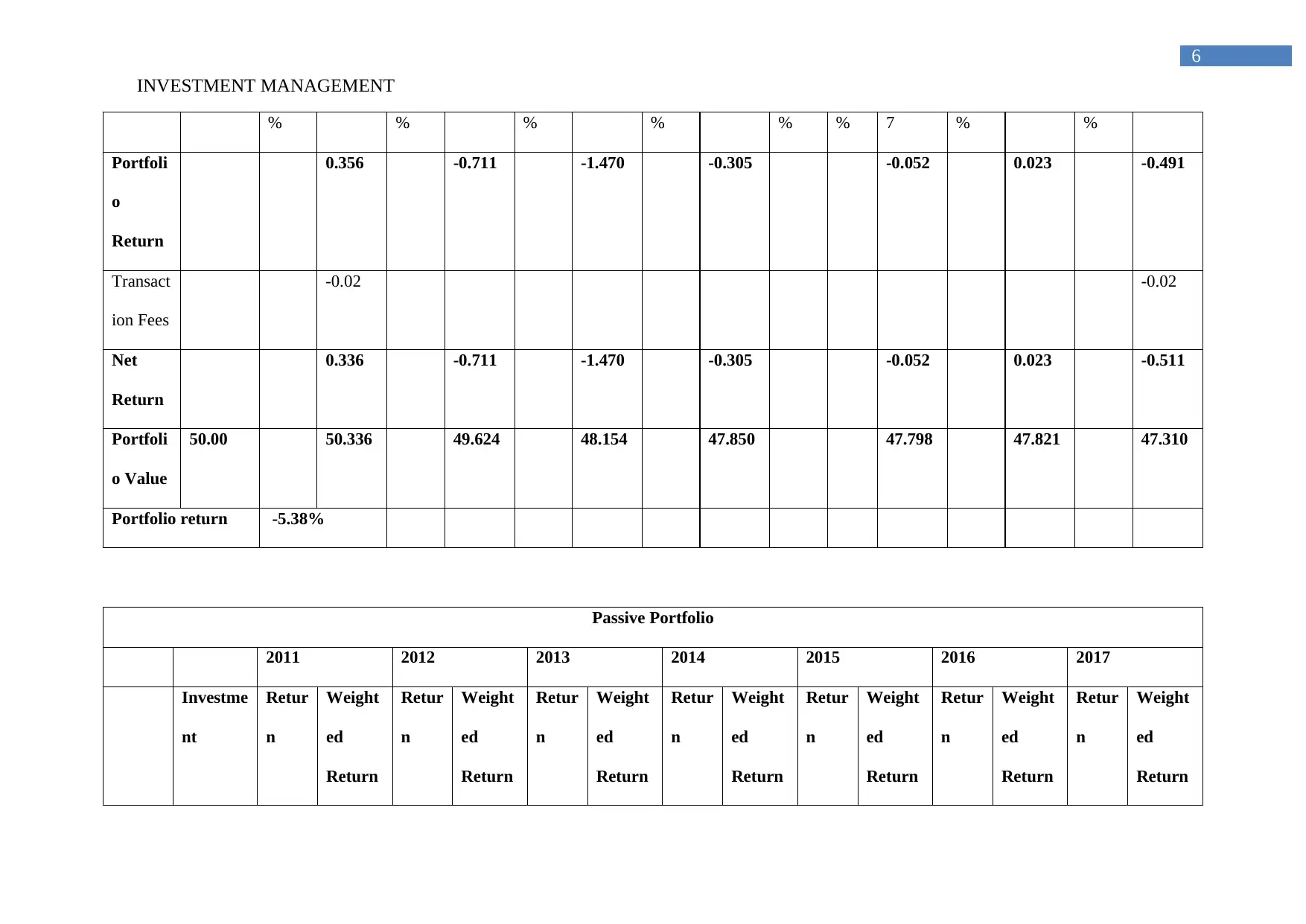
INVESTMENT MANAGEMENT
6
% % % % % % 7 % %
Portfoli
o
Return
0.356 -0.711 -1.470 -0.305 -0.052 0.023 -0.491
Transact
ion Fees
-0.02 -0.02
Net
Return
0.336 -0.711 -1.470 -0.305 -0.052 0.023 -0.511
Portfoli
o Value
50.00 50.336 49.624 48.154 47.850 47.798 47.821 47.310
Portfolio return -5.38%
Passive Portfolio
2011 2012 2013 2014 2015 2016 2017
Investme
nt
Retur
n
Weight
ed
Return
Retur
n
Weight
ed
Return
Retur
n
Weight
ed
Return
Retur
n
Weight
ed
Return
Retur
n
Weight
ed
Return
Retur
n
Weight
ed
Return
Retur
n
Weight
ed
Return
6
% % % % % % 7 % %
Portfoli
o
Return
0.356 -0.711 -1.470 -0.305 -0.052 0.023 -0.491
Transact
ion Fees
-0.02 -0.02
Net
Return
0.336 -0.711 -1.470 -0.305 -0.052 0.023 -0.511
Portfoli
o Value
50.00 50.336 49.624 48.154 47.850 47.798 47.821 47.310
Portfolio return -5.38%
Passive Portfolio
2011 2012 2013 2014 2015 2016 2017
Investme
nt
Retur
n
Weight
ed
Return
Retur
n
Weight
ed
Return
Retur
n
Weight
ed
Return
Retur
n
Weight
ed
Return
Retur
n
Weight
ed
Return
Retur
n
Weight
ed
Return
Retur
n
Weight
ed
Return
Paraphrase This Document
Need a fresh take? Get an instant paraphrase of this document with our AI Paraphraser
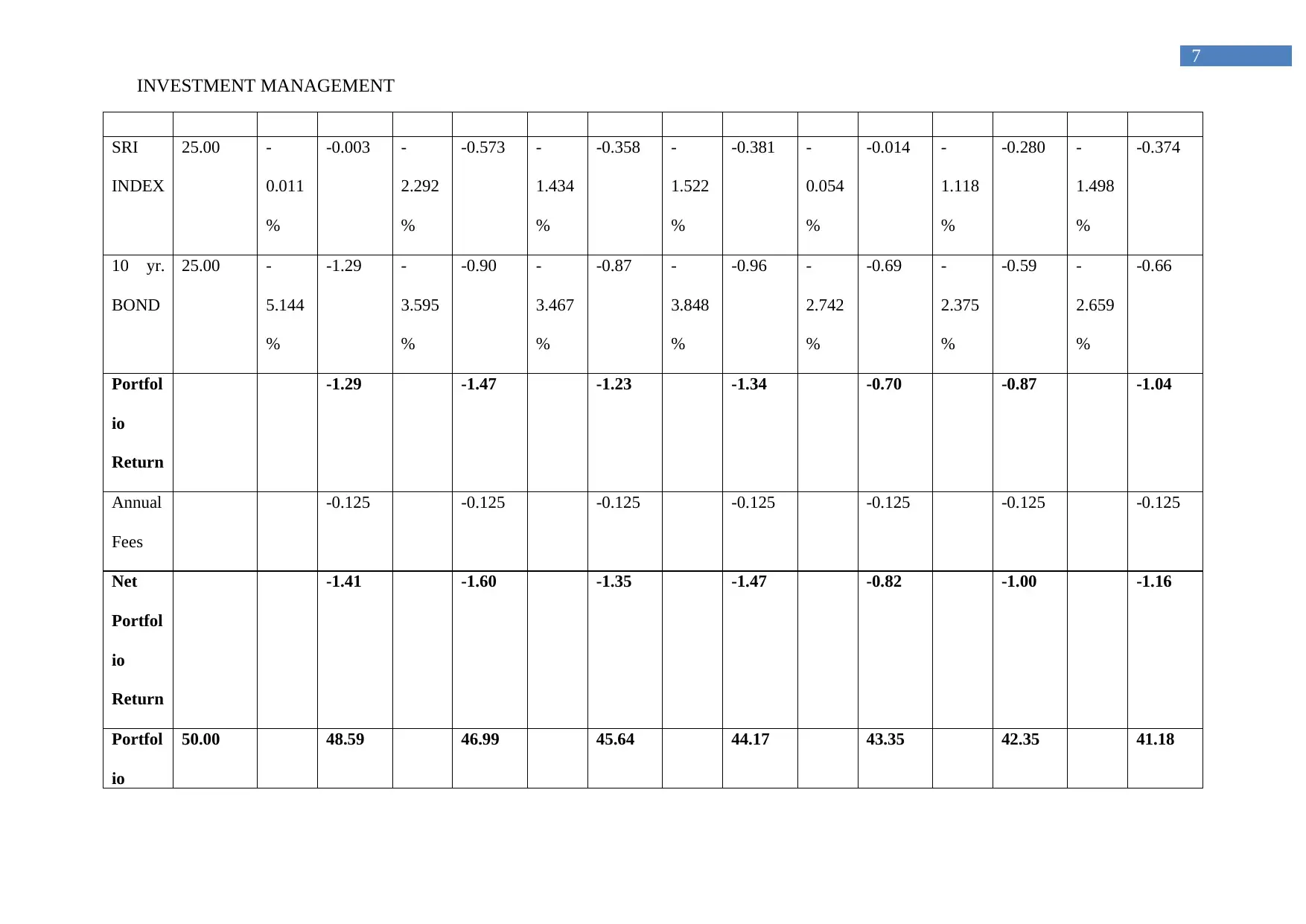
INVESTMENT MANAGEMENT
7
SRI
INDEX
25.00 -
0.011
%
-0.003 -
2.292
%
-0.573 -
1.434
%
-0.358 -
1.522
%
-0.381 -
0.054
%
-0.014 -
1.118
%
-0.280 -
1.498
%
-0.374
10 yr.
BOND
25.00 -
5.144
%
-1.29 -
3.595
%
-0.90 -
3.467
%
-0.87 -
3.848
%
-0.96 -
2.742
%
-0.69 -
2.375
%
-0.59 -
2.659
%
-0.66
Portfol
io
Return
-1.29 -1.47 -1.23 -1.34 -0.70 -0.87 -1.04
Annual
Fees
-0.125 -0.125 -0.125 -0.125 -0.125 -0.125 -0.125
Net
Portfol
io
Return
-1.41 -1.60 -1.35 -1.47 -0.82 -1.00 -1.16
Portfol
io
50.00 48.59 46.99 45.64 44.17 43.35 42.35 41.18
7
SRI
INDEX
25.00 -
0.011
%
-0.003 -
2.292
%
-0.573 -
1.434
%
-0.358 -
1.522
%
-0.381 -
0.054
%
-0.014 -
1.118
%
-0.280 -
1.498
%
-0.374
10 yr.
BOND
25.00 -
5.144
%
-1.29 -
3.595
%
-0.90 -
3.467
%
-0.87 -
3.848
%
-0.96 -
2.742
%
-0.69 -
2.375
%
-0.59 -
2.659
%
-0.66
Portfol
io
Return
-1.29 -1.47 -1.23 -1.34 -0.70 -0.87 -1.04
Annual
Fees
-0.125 -0.125 -0.125 -0.125 -0.125 -0.125 -0.125
Net
Portfol
io
Return
-1.41 -1.60 -1.35 -1.47 -0.82 -1.00 -1.16
Portfol
io
50.00 48.59 46.99 45.64 44.17 43.35 42.35 41.18

INVESTMENT MANAGEMENT
8
Value
Portfolio return -17.63%
8
Value
Portfolio return -17.63%
⊘ This is a preview!⊘
Do you want full access?
Subscribe today to unlock all pages.

Trusted by 1+ million students worldwide

INVESTMENT MANAGEMENT
9
1. Explaining an in-depth, critical and reflective way the strategies relevant active
portfolio adheres to and financial theory the strategies are based on:
There are relevant strategies that are maintained by investors to adequately increase
their return from investment. In addition, the use of market timing strategy and value
screening strategy is mainly used in the active portfolio, which helps in improving the return
generating capacity of the investor. The financial performance of the company is also used in
selecting the overall stock for the portfolio. The use of both the strategies mainly help in
improving return of the active portfolio, while the portfolio for passive strategy does not use
both the strategy. Balance (2014) mentioned that with the help of adequate investment
strategy investor are able to increase the rate of return and reduce any kind of risk involved in
investments further elaboration on the overall strategy is mainly elaborated.
Marketing timing strategy:
Market timing strategy is one of the essential ways that allows the investors to
identify investment opportunities within the capital market. this investment opportunities are
mainly identified with the help of relevant tools such as technical analysis, stock valuation
analysis and analysis of economic forecasting. The investors mainly use these technical tools
to identify investment opportunities within a stock and generate higher returns from the
investment. Furthermore, investors with the help of market timing strategy can predict
bullish phase and bearish phase, which are present within a company’s stock. This market
timings are mainly useful in detecting major ups and downs in the market, which directly
maximizes the overall return generated from an investment. just adequate investment
strategy is used in the current active portfolio for driving the returns generated from the
combined SRI and Non-SRI stocks. The strategy mainly helps in selecting the stocks at low
levels, which could help in improving the relevant returns from investment (Chandra 2017).
9
1. Explaining an in-depth, critical and reflective way the strategies relevant active
portfolio adheres to and financial theory the strategies are based on:
There are relevant strategies that are maintained by investors to adequately increase
their return from investment. In addition, the use of market timing strategy and value
screening strategy is mainly used in the active portfolio, which helps in improving the return
generating capacity of the investor. The financial performance of the company is also used in
selecting the overall stock for the portfolio. The use of both the strategies mainly help in
improving return of the active portfolio, while the portfolio for passive strategy does not use
both the strategy. Balance (2014) mentioned that with the help of adequate investment
strategy investor are able to increase the rate of return and reduce any kind of risk involved in
investments further elaboration on the overall strategy is mainly elaborated.
Marketing timing strategy:
Market timing strategy is one of the essential ways that allows the investors to
identify investment opportunities within the capital market. this investment opportunities are
mainly identified with the help of relevant tools such as technical analysis, stock valuation
analysis and analysis of economic forecasting. The investors mainly use these technical tools
to identify investment opportunities within a stock and generate higher returns from the
investment. Furthermore, investors with the help of market timing strategy can predict
bullish phase and bearish phase, which are present within a company’s stock. This market
timings are mainly useful in detecting major ups and downs in the market, which directly
maximizes the overall return generated from an investment. just adequate investment
strategy is used in the current active portfolio for driving the returns generated from the
combined SRI and Non-SRI stocks. The strategy mainly helps in selecting the stocks at low
levels, which could help in improving the relevant returns from investment (Chandra 2017).
Paraphrase This Document
Need a fresh take? Get an instant paraphrase of this document with our AI Paraphraser
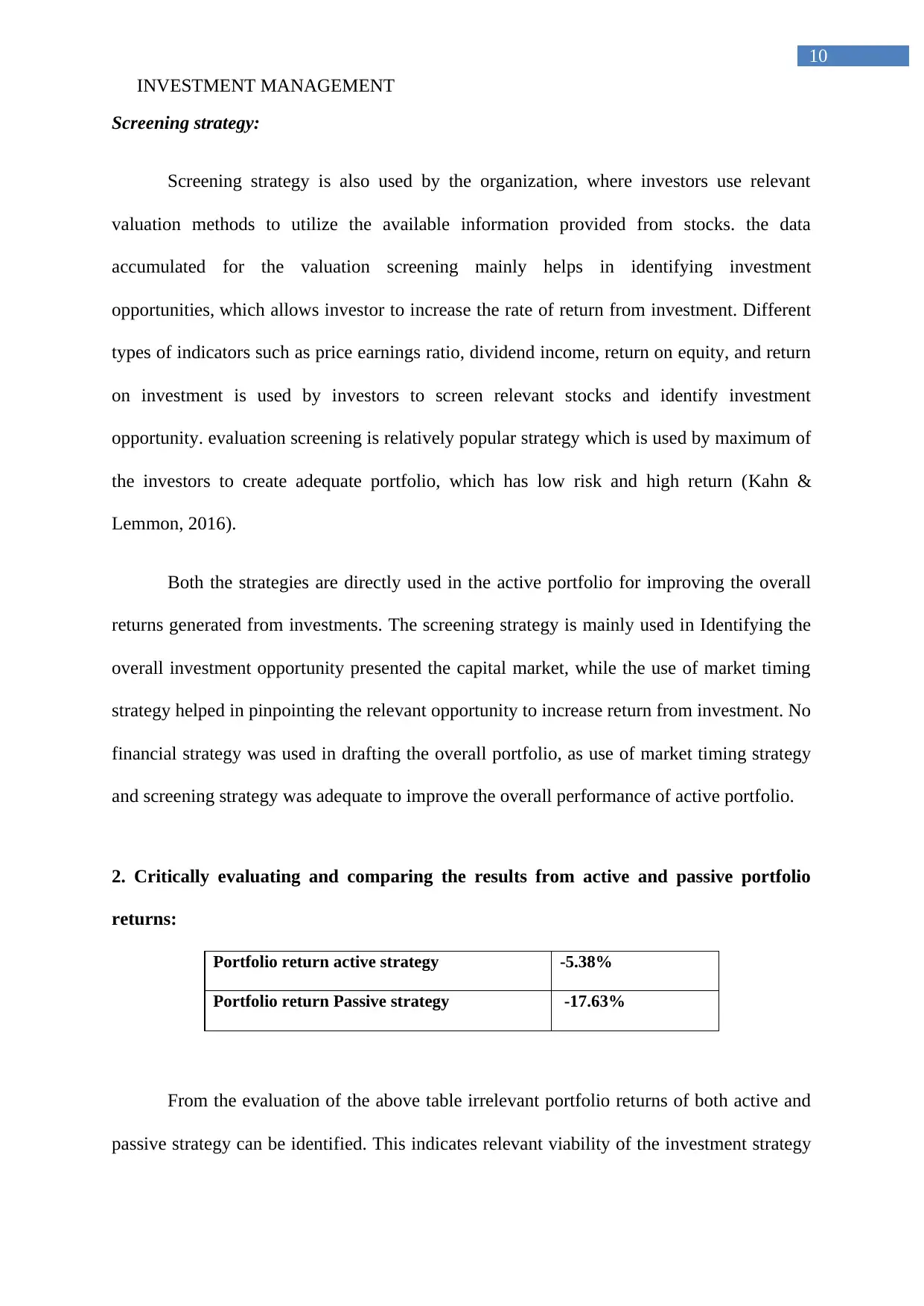
INVESTMENT MANAGEMENT
10
Screening strategy:
Screening strategy is also used by the organization, where investors use relevant
valuation methods to utilize the available information provided from stocks. the data
accumulated for the valuation screening mainly helps in identifying investment
opportunities, which allows investor to increase the rate of return from investment. Different
types of indicators such as price earnings ratio, dividend income, return on equity, and return
on investment is used by investors to screen relevant stocks and identify investment
opportunity. evaluation screening is relatively popular strategy which is used by maximum of
the investors to create adequate portfolio, which has low risk and high return (Kahn &
Lemmon, 2016).
Both the strategies are directly used in the active portfolio for improving the overall
returns generated from investments. The screening strategy is mainly used in Identifying the
overall investment opportunity presented the capital market, while the use of market timing
strategy helped in pinpointing the relevant opportunity to increase return from investment. No
financial strategy was used in drafting the overall portfolio, as use of market timing strategy
and screening strategy was adequate to improve the overall performance of active portfolio.
2. Critically evaluating and comparing the results from active and passive portfolio
returns:
Portfolio return active strategy -5.38%
Portfolio return Passive strategy -17.63%
From the evaluation of the above table irrelevant portfolio returns of both active and
passive strategy can be identified. This indicates relevant viability of the investment strategy
10
Screening strategy:
Screening strategy is also used by the organization, where investors use relevant
valuation methods to utilize the available information provided from stocks. the data
accumulated for the valuation screening mainly helps in identifying investment
opportunities, which allows investor to increase the rate of return from investment. Different
types of indicators such as price earnings ratio, dividend income, return on equity, and return
on investment is used by investors to screen relevant stocks and identify investment
opportunity. evaluation screening is relatively popular strategy which is used by maximum of
the investors to create adequate portfolio, which has low risk and high return (Kahn &
Lemmon, 2016).
Both the strategies are directly used in the active portfolio for improving the overall
returns generated from investments. The screening strategy is mainly used in Identifying the
overall investment opportunity presented the capital market, while the use of market timing
strategy helped in pinpointing the relevant opportunity to increase return from investment. No
financial strategy was used in drafting the overall portfolio, as use of market timing strategy
and screening strategy was adequate to improve the overall performance of active portfolio.
2. Critically evaluating and comparing the results from active and passive portfolio
returns:
Portfolio return active strategy -5.38%
Portfolio return Passive strategy -17.63%
From the evaluation of the above table irrelevant portfolio returns of both active and
passive strategy can be identified. This indicates relevant viability of the investment strategy
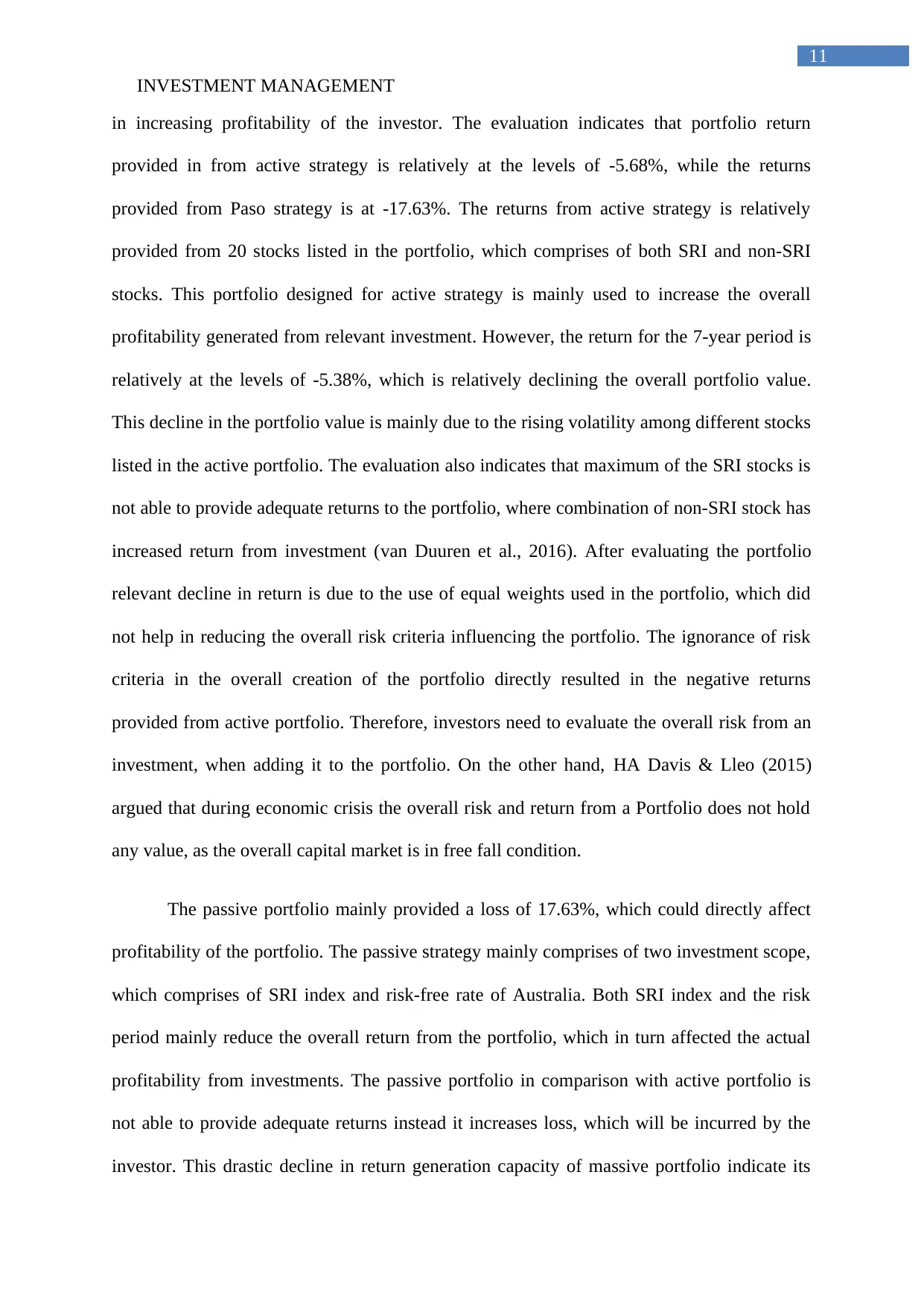
INVESTMENT MANAGEMENT
11
in increasing profitability of the investor. The evaluation indicates that portfolio return
provided in from active strategy is relatively at the levels of -5.68%, while the returns
provided from Paso strategy is at -17.63%. The returns from active strategy is relatively
provided from 20 stocks listed in the portfolio, which comprises of both SRI and non-SRI
stocks. This portfolio designed for active strategy is mainly used to increase the overall
profitability generated from relevant investment. However, the return for the 7-year period is
relatively at the levels of -5.38%, which is relatively declining the overall portfolio value.
This decline in the portfolio value is mainly due to the rising volatility among different stocks
listed in the active portfolio. The evaluation also indicates that maximum of the SRI stocks is
not able to provide adequate returns to the portfolio, where combination of non-SRI stock has
increased return from investment (van Duuren et al., 2016). After evaluating the portfolio
relevant decline in return is due to the use of equal weights used in the portfolio, which did
not help in reducing the overall risk criteria influencing the portfolio. The ignorance of risk
criteria in the overall creation of the portfolio directly resulted in the negative returns
provided from active portfolio. Therefore, investors need to evaluate the overall risk from an
investment, when adding it to the portfolio. On the other hand, HA Davis & Lleo (2015)
argued that during economic crisis the overall risk and return from a Portfolio does not hold
any value, as the overall capital market is in free fall condition.
The passive portfolio mainly provided a loss of 17.63%, which could directly affect
profitability of the portfolio. The passive strategy mainly comprises of two investment scope,
which comprises of SRI index and risk-free rate of Australia. Both SRI index and the risk
period mainly reduce the overall return from the portfolio, which in turn affected the actual
profitability from investments. The passive portfolio in comparison with active portfolio is
not able to provide adequate returns instead it increases loss, which will be incurred by the
investor. This drastic decline in return generation capacity of massive portfolio indicate its
11
in increasing profitability of the investor. The evaluation indicates that portfolio return
provided in from active strategy is relatively at the levels of -5.68%, while the returns
provided from Paso strategy is at -17.63%. The returns from active strategy is relatively
provided from 20 stocks listed in the portfolio, which comprises of both SRI and non-SRI
stocks. This portfolio designed for active strategy is mainly used to increase the overall
profitability generated from relevant investment. However, the return for the 7-year period is
relatively at the levels of -5.38%, which is relatively declining the overall portfolio value.
This decline in the portfolio value is mainly due to the rising volatility among different stocks
listed in the active portfolio. The evaluation also indicates that maximum of the SRI stocks is
not able to provide adequate returns to the portfolio, where combination of non-SRI stock has
increased return from investment (van Duuren et al., 2016). After evaluating the portfolio
relevant decline in return is due to the use of equal weights used in the portfolio, which did
not help in reducing the overall risk criteria influencing the portfolio. The ignorance of risk
criteria in the overall creation of the portfolio directly resulted in the negative returns
provided from active portfolio. Therefore, investors need to evaluate the overall risk from an
investment, when adding it to the portfolio. On the other hand, HA Davis & Lleo (2015)
argued that during economic crisis the overall risk and return from a Portfolio does not hold
any value, as the overall capital market is in free fall condition.
The passive portfolio mainly provided a loss of 17.63%, which could directly affect
profitability of the portfolio. The passive strategy mainly comprises of two investment scope,
which comprises of SRI index and risk-free rate of Australia. Both SRI index and the risk
period mainly reduce the overall return from the portfolio, which in turn affected the actual
profitability from investments. The passive portfolio in comparison with active portfolio is
not able to provide adequate returns instead it increases loss, which will be incurred by the
investor. This drastic decline in return generation capacity of massive portfolio indicate its
⊘ This is a preview!⊘
Do you want full access?
Subscribe today to unlock all pages.

Trusted by 1+ million students worldwide
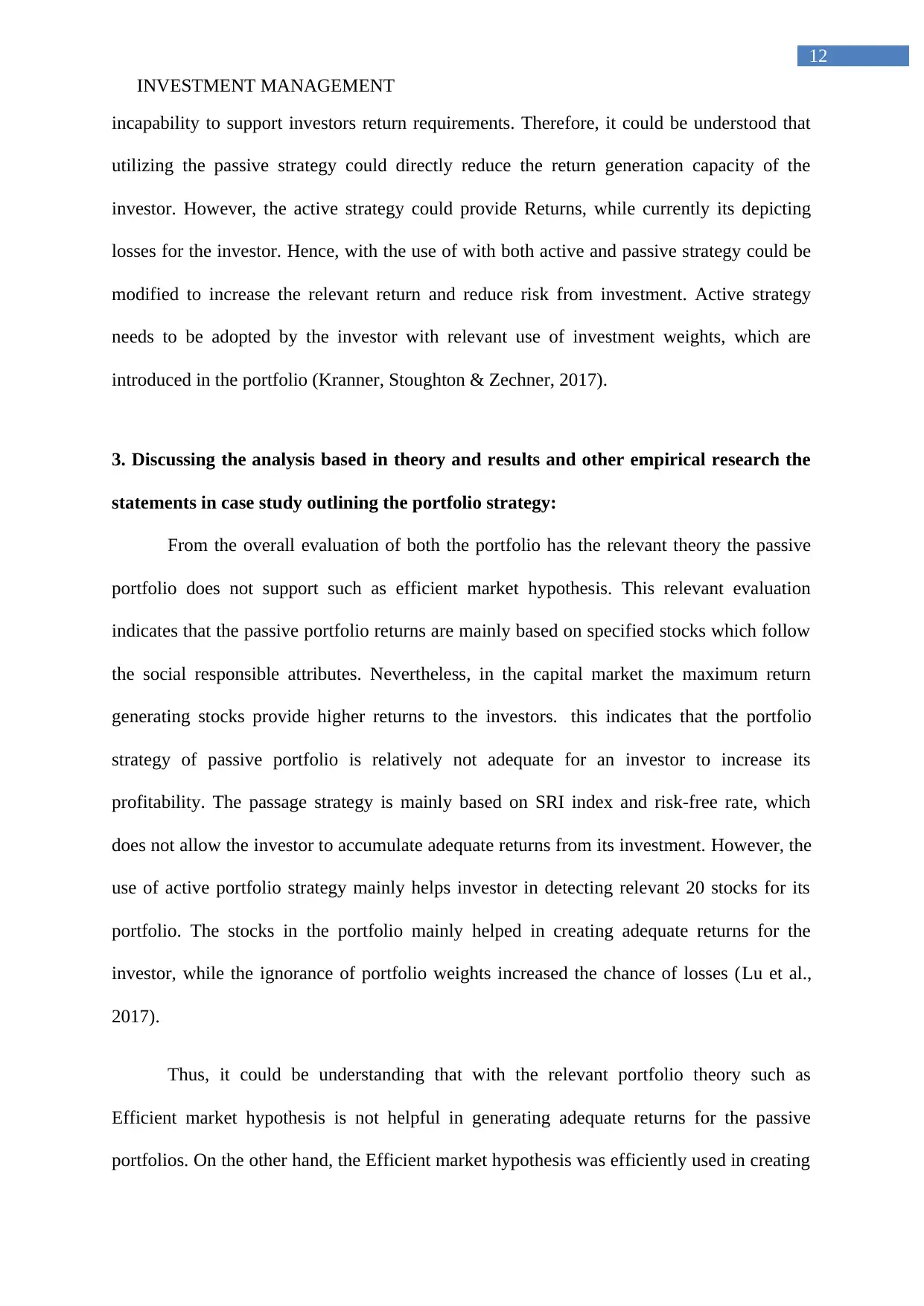
INVESTMENT MANAGEMENT
12
incapability to support investors return requirements. Therefore, it could be understood that
utilizing the passive strategy could directly reduce the return generation capacity of the
investor. However, the active strategy could provide Returns, while currently its depicting
losses for the investor. Hence, with the use of with both active and passive strategy could be
modified to increase the relevant return and reduce risk from investment. Active strategy
needs to be adopted by the investor with relevant use of investment weights, which are
introduced in the portfolio (Kranner, Stoughton & Zechner, 2017).
3. Discussing the analysis based in theory and results and other empirical research the
statements in case study outlining the portfolio strategy:
From the overall evaluation of both the portfolio has the relevant theory the passive
portfolio does not support such as efficient market hypothesis. This relevant evaluation
indicates that the passive portfolio returns are mainly based on specified stocks which follow
the social responsible attributes. Nevertheless, in the capital market the maximum return
generating stocks provide higher returns to the investors. this indicates that the portfolio
strategy of passive portfolio is relatively not adequate for an investor to increase its
profitability. The passage strategy is mainly based on SRI index and risk-free rate, which
does not allow the investor to accumulate adequate returns from its investment. However, the
use of active portfolio strategy mainly helps investor in detecting relevant 20 stocks for its
portfolio. The stocks in the portfolio mainly helped in creating adequate returns for the
investor, while the ignorance of portfolio weights increased the chance of losses (Lu et al.,
2017).
Thus, it could be understanding that with the relevant portfolio theory such as
Efficient market hypothesis is not helpful in generating adequate returns for the passive
portfolios. On the other hand, the Efficient market hypothesis was efficiently used in creating
12
incapability to support investors return requirements. Therefore, it could be understood that
utilizing the passive strategy could directly reduce the return generation capacity of the
investor. However, the active strategy could provide Returns, while currently its depicting
losses for the investor. Hence, with the use of with both active and passive strategy could be
modified to increase the relevant return and reduce risk from investment. Active strategy
needs to be adopted by the investor with relevant use of investment weights, which are
introduced in the portfolio (Kranner, Stoughton & Zechner, 2017).
3. Discussing the analysis based in theory and results and other empirical research the
statements in case study outlining the portfolio strategy:
From the overall evaluation of both the portfolio has the relevant theory the passive
portfolio does not support such as efficient market hypothesis. This relevant evaluation
indicates that the passive portfolio returns are mainly based on specified stocks which follow
the social responsible attributes. Nevertheless, in the capital market the maximum return
generating stocks provide higher returns to the investors. this indicates that the portfolio
strategy of passive portfolio is relatively not adequate for an investor to increase its
profitability. The passage strategy is mainly based on SRI index and risk-free rate, which
does not allow the investor to accumulate adequate returns from its investment. However, the
use of active portfolio strategy mainly helps investor in detecting relevant 20 stocks for its
portfolio. The stocks in the portfolio mainly helped in creating adequate returns for the
investor, while the ignorance of portfolio weights increased the chance of losses (Lu et al.,
2017).
Thus, it could be understanding that with the relevant portfolio theory such as
Efficient market hypothesis is not helpful in generating adequate returns for the passive
portfolios. On the other hand, the Efficient market hypothesis was efficiently used in creating
1 out of 13
Your All-in-One AI-Powered Toolkit for Academic Success.
+13062052269
info@desklib.com
Available 24*7 on WhatsApp / Email
![[object Object]](/_next/static/media/star-bottom.7253800d.svg)
Unlock your academic potential
© 2024 | Zucol Services PVT LTD | All rights reserved.
